
The House of Representatives, that is. Here is a long lens snap of Republican House Speaker Dennis Hastert climbing out of the hydrogen-powered minivan he’d just appeared in at a “we feel your gas prices pain” photo-op–and into his official SUV in order to, as the AP caption puts it on Yahoo, “drive the few blocks back to the U.S. Capitol.”
Sweet. Hats off to AP snapper Pablo Martinez Monsivais for the get, and thanks to the morning news for the tip.
Clearly, What’s Super Is His Publicity Machine
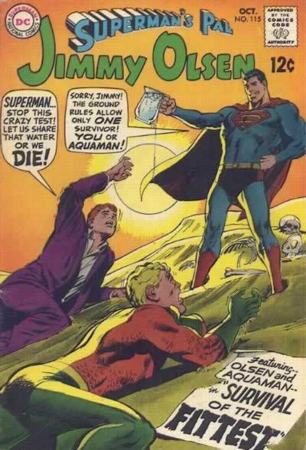
The American Way, indeed. Ouch.
Superman is a dick. [via themorningnews]
Kids These Days
You’d never know it from the market today, but according to the Guardian’s Jonathan Jones, art and money do NOT go well together.
That’s his explanation for why Damien Hirst sucks so bad these days–because he has 100 million pounds–and he’s sticking with it. Same thing happened to Dali and Warhol, the chumps. Got all caught up in the money and the fame and the trappings and neglected the art.
OK… never mind that alongside his sellout portrait factory, Warhol did make interesting and even important work throughout his career. And never mind that Dali was the diametric opposite, a fraud who exploited his early influence and flooded his own market with counterfeits and crap. Who IS Jones’ idea of an artist who doesn’t let making a ton of money bring his art down?
The most brilliant concealer of wealth was Picasso. From his 30s onwards, the modern master could afford the best studios and houses. But when we look at his painting of his studio on his Cannes estate we don’t think of him as rich in the same vulgar way as Dali. This is because Picasso lived for work…
Uh-huh. Because with only 10,000,000 ceramics and that Frankie Goes To Hollywood album cover, the Cannes Estate Period produced some of Picasso’s most important works.
Do rich artists make bad art? [guardian]
Hu-haha: The Politics Of Camera Angles
When I heard the NPR report of all the pomp and ceremony and symbolism on display during Chinese President Hu Jintao’s visit to the White House yesterday, I expected the news service photos to show a classic Sforzian set, with all the carefully calibrated money shots: statesman-like profiles while the two men review the troops; dual podiums with a Sforzian Background of artfully fluffed flags. You know, like the kind of thing White House Prod. did when they went to China. And Mongolia.
Given the amount of preproduction for these events–which are designed to exist as and generate media, not as live experiences, remember–I was immediately suspicious when I heard a Falun Gong protestor turned up. And that she wasn’t hustled off for several minutes. And that she was a print reporter on the TV camera platform.
[After all, if there’s one thing Bush Republicans have demonstrated their competence in, it’s their ability to pack a crowd and the ruthless efficiency with which they dispatch any off-message disruptors.]
But in fact, the Hu Jintao slideshow on Yahoo News [my usual source for Sforza’s work, and the source of these images] totally shocked me. There were a couple of very tight portraits, but there was absolutely none of Sforza’s signature preset money shots. None.

The event was certainly large and stagey, with throngs of supporters and colonial marching bands and flags everywhere, but Sforza’s strength in imagecraft is in designing camera positions and backdrops and foregrounds that give photographers and cameramen gorgeous, easily read shots that are so easy to take, journalists don’t mind leaving the editorial decisions to the White House. There was absolutely none of that in the Hu-Bush images.
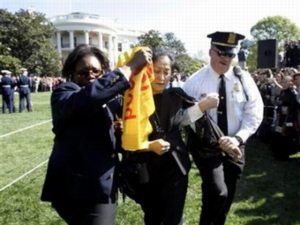
If anything, they showed the exact opposite. The images are tight and indistinct, shot from too close or too low. And the backgrounds are almost random.
Even without knowing the Falun Gong protestor was frogmarched out in front of everybody, it was obvious that WHP intended for this event to look different and to be read differently. [They knew it was being carried live in China.] Every other aspect of production seemed to be in place; so I can’t imagine Sforza falling asleep on the shot composition. The only other explanation is that every wire service sent an intern to shoot the event. And you’d have to be a pretty big conspiracy nut to believe that.
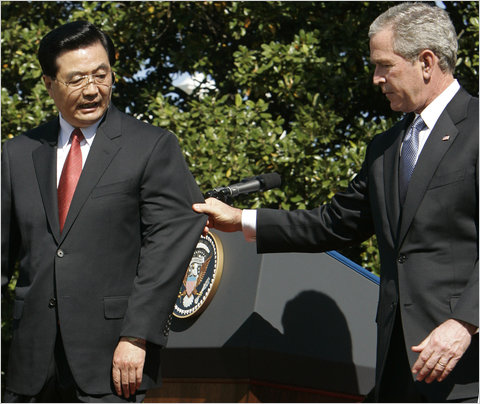
George Bush giving a tug to Chinese President Hu Jintao, Apr 20, 2006, image: Jim Bourg/Reuters via NYT
Add to that the announcer calling China the “Republic of China,” and the images of Bush tugging at Hu’s sleeve to stop him from going down the wrong stairs, an atypical gesture he had to know would set the shutters clicking, and there is no doubt in my mind that the event produced exactly the images the White House expected it would.
The White House went through all the diplomatic motions of producing a showy event, then they fed reporters stories of the Chinese penchant for showy events and symbolism, including their request for a state dinner, which was rejected. And then they sabotaged the whole thing in a few crucial but plausibly deniable ways to send a message that may or may not have ended up on Chinese TV.
And to remind China who’s still the boss around here.
The Agency For Unrealised Projects [With An ‘S’]

Just came across the transom from e-flux:
Serpentine Gallery and e-flux announce Agency for Unrealised Projects (AUP)
For every planned project that is carried out, hundreds of other proposals by artists, architects, designers, scientists and other practitioners around the world stay unrealised and invisible to the public. Agency for Unrealised Projects (AUP) seeks to document and display these works through publications, a developing archive and a physical office, in this way charting the terrain of a contingent future.
Unlike unrealised architectural models and projects submitted for competitions, which are frequently published and discussed, public endeavours in the visual arts that are planned but not carried out ordinarily remain unnoticed or little known. The aim of the Agency for Unrealised Projects (AUP), starting from an archive amassed by Hans Ulrich Obrist over the last 10 years and continuing to invite submissions by artists, is to give life to these as yet unachievable plans, by making them available to the public to be disseminated, discussed and most importantly, to be realised.
This is the first in a series of new projects and programmes for the Serpentine Gallery devised by Julia Peyton-Jones, Director, Serpentine Gallery and Hans Ulrich Obrist, Co-Director, Exhibitions and Programmes and Director of International Projects.
The Agency for Unrealised Projects (AUP) will also be the first in a programme of research and collaborations with e-flux, under the name Institute for New Social Research, initiated by Julieta Aranda and Anton Vidokle.
I suddenly feel the need for a more institutional-sounding name.
Forthwith please direct all correspondence to Greg Allen, Managing Director, General Research & Entertainment Group.
Previously: I wrote about HUO’s Unrealized Projects [with a ‘Z’] research last year for the NYT.
Letters! We Get Letters!
Dear Representatives of,
I visited you site as was interested in film “Black Book’s riotous Inside the Actor Love/Hate Studio session…” by Screenwriter Paul Thomas Anderson. I was very surprised and disillusioned to find out the link to the cigarettes web-store ptanderson.com on the page as I’m a non-smoker.
This whole situation is disappointing because the subject of this film is against smoking.
That’s why I kindly ask you to remove this link from your site! With
hope for your cooperation and understanding to this matter!
Best regards,
Sure enough, the URL for what I once called “the blow-away best ‘unofficial’ filmmaker fansite around”, Cigarettes & Coffee, [after his first short], has been taken over by a cigarette retailer.
Perhaps there was a trademark dispute with Mr Anderson, or perhaps the bigtime studio lawyers behind Jim Jarmusch’s Coffee & Cigarettes muscled them into changing it. You know what a Hollywood monkey Jarmusch is.
In any case, the fansite is now called Cigarettes & Red Vines, and can be found at cigarettesandredvines.com. Can’t imagine any trademark problems with that one.
PTAnderson.com is now Cigarettesandredvines.com. Please adjust your links accordingly. Thank you.
Wonder Showzen Guys Give Onion Interviewer Grief
Nice. If this guy worked for anyplace but The Onion AV Club, he’d have left this interview shaking like a leaf wondering how he’s gonna get his story done.
JL: My favorite moments are when you see someone lash out at the puppet, and then we have the guts, after he hits us, to move closer. There’s so many times that someone hits us and we just run away like babies. There’s a guy who pulled a knife on us, and we kept going toward him.
VC: We ran away, and then from a distance, we said, “Okay, now let’s learn to love each other. What will it take? We’ll take baby steps.”
JL: And he’s holding the knife out.
VC: And then we took little steps closer, and within five steps, he started to go for us, and we took off.
JL: That guy was saying to himself, “I just don’t want to go back to jail.” And that was our protective bubble.
Wonder Showzen season 2 is on these days. [avclub.com via waxy]
Coming Soon To A Coffee Table Near Me: Cartoon Modern
Cartoon Modern is Amid Amidi’s blog which accompanies his forthcoming book of the same name, Cartoon Modern: Style and Design in Fifties Animation.
Good stuff. Here, for example, he talks about how inexperience and an inability to collaborate with other animators undercut art director Evyind Earle’s contributions on Sleeping Beauty.
There’s a lot more, and I expect the book will be gorgeous.
Cartoon Modern, via Amidi’s all-animation blog, Cartoon Brew.
The Manchester Passion, Unplugged
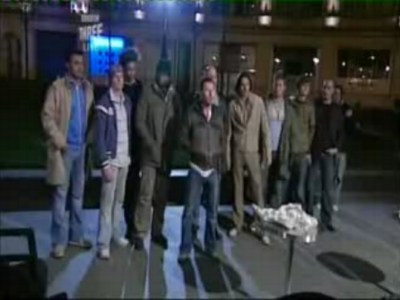
BBC3 produced and aired “Manchester Passion” Friday night, a live retelling of the Passion of Christ, that was set on the streets of Manchester and which featured music from local bands made good like Joy Division and Oasis.
The hype was definitely set: the Guardian published a lengthy article from the rehearsals. But I’ve heard precious little about how it actually turned out. Never mind finding any videos or torrents of the actual broadcast.
YouTube, is there anything you can’t do? So far, there are clips of Jesus singing “Love will tear us apart” at the Last Supper, and a Smiths/Morissey fest, Jesus singing “You’re Gonna Need Someone On Your Side”” and Judas singing “Heaven knows I’m miserable now.”
The production looks pretty raw and unplugged, a theater-on-the-fly mix of live event/procession and stage/set pieces. I cannot imagine in a million years that an American company would ever produce something like this. Instead, we get Mel Gibson.
Day that Jesus came to the Arndale Centre [guardian.co.uk]
Manchester Passion website at BBC3 [bbc.co.uk]
“Manchester Passion” on YouTube [youtube.com]
Airport Movie Full Of Symbols
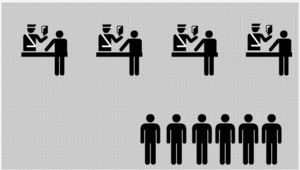
Iain Anderson’s Airport is an animated short film made entirely of AIGA-standard travel icons. Very cute.
Airport by Iain Anderson [funwithstuff.com via boingboing]
There Are Many Paths To The Top Of Mt. Fuji
That fall the curious flocked to Gladstone’s gallery to watch a film depicting him scaling the gallery walls with the help of ice screws. It ended with Barney inserting the last screw into his anus. Stardom came instantaneously.
Unfortunately, the rest of “Barney’s Voyage,” Julie Belcove’s profile of Matthew Barney and Drawing Restraint 9 for W Magazine, is not available online.
But Randy Kennedy’s profile for the Times is, and he clears up the whole “Bjork and Matthew Barney live in New Jersey!” mystery that had the Noel Coward people so up in arms.
Sikhs On A Train
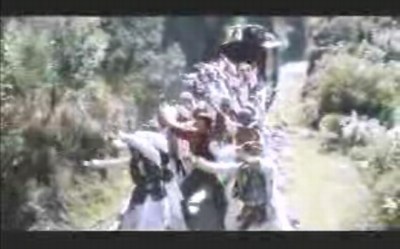
As soon as it started, I knew that “Chaiyya Chaiyya,” a song from the 1998 breakout Indian film Dil Se directed by Mani Ratnam with music by A. R. Rahman, would make my list of Favorite Music Videos Shot On A Train.
Right now it’s duking it out with Lars von Trier’s and Bjork’s train song from Dancer In The Dark from the top spot. It is, at the moment, a two-song list.
Chaiyya Chaiyya, from Dil Se [youtube via tmn]
Previously: 101 Cameras: Lars von Trier and Me
Death And Venice

Felix Gonzalez-Torres: “All art and all cultural production is political.”
The NY Times report on the inclusion of Felix Gonzalez-Torres’ works in US Pavilion next year in Venice gives more information on what was included in the Guggenheim’s proposal. Here is what the pieces soud like to me, starting with the “never before realized” work, which will be installed in the entrance courtyard of the pavilion:
Like that “figure eight = infinity” bit, Carol Vogel provided cleanly didactic interpretations of Felix’s symbolism: “stacks of replenishable paper to represent the inevitability of death, strings of lights to represent dreams of a better world.” So it’s odd that a presumably easy-to-read “symbol” like a black border–which, on stationery and signage, has long signified a house in mourning–didn’t get a mention. Nor did the title: Untitled (Republican Years).
1985 Act Up 1989 FU State Dept. 1996 Died 2007 Venice Biennale

Like death and taxes, the State Department will catch up with you. One day.
From an interview Felix Gonzalez-Torres once did with Rob Storr
For example, here is something the State Department sent to me in 1989, asking me to submit work to the Art and Embassy Program. It has this wonderful quote from George Bernard Shaw, which says, “Besides torture, art is the most persuasive weapon.” And I said I didn’t know that the State Department had given up on torture – they’re probably not giving up on torture – but they’re using both. Anyway, look at this letter, because in case you missed the point they reproduce a Franz Kline which explains very well what they want in this program. It’s a very interesting letter, because it’s so transparent.
Another example: when you have a show with white male straight painters, you don’t call it that, that would be absurd, right? That’s just not “natural”. But if you have four Black lesbian sculptors from Brooklyn, that’s exactly what you call it, “Four African-American Lesbians from Brooklyn.”
Now, ten years and a couple of months after his death, the State Department announced that Gonzalez-Torres’ work has been selected for the US Pavilion at next year’s Venice Biennale. Nancy Spector, who wrote the book on Felix–no, the other one; the one that Andrea Rosen didn’t write–will curate.
According to the State Department press release, “For the exhibition, Ms. Spector will include a new work, made from a drawing by Mr. Gonzalez-Torres but unrealized in his lifetime.”
As Felix’s Cuban–I mean, Cuban-American–countryman was famous for saying, somebody’s got some ‘splainin’ to do.
Cuban-American Artist To Be Featured at International Exhibit [state.gov via artforum]
previously: On Politics and Art
Walker Center Nice
I want to love the Walker Center’s Walker Channel video streams even more than I do.
There was a chat between Rirkrit Tiravanija and writer Bruce Sterling, for example [here’s the Walker’s blog post about it]
And Philippe Vergne talking with Dan Graham and his collaborators on his punk puppet opera Don’t trust anyone over 30.
And of course, Tyler was on the edge of his seat, waiting to watch the knives fly in realtime during the Whitney Biennial recap with Philippe and Chrissie Iles.
But unfortunately, the videos just aren’t doing it for me. They’re polite and non-confrontational to the extreme; they capture all of the tedium of a public event–including too-long intros and fawning, populist comments [Philippe actually asked Dan Graham, in his French accent, “Wat de heck am I looking at ‘ere?”]–with none of the excitement of being in the room.
And while the Rirkrit/Bruce dialogue mashup probably seemed great on paper, it didn’t work out. It was obvious that, by personality or arrangement, Bruce was “supposed” to be the “host,” asking questions, but he couldn’t help but launch into his own set pieces about how many laptops he has and how he powers them. Rirkrit, bless his heart, managed to come off as deeply incurious, even though he was presumably there to be asked about his work.
Finally, I don’t know if it’s my NYC-impaired hearing or some self-effacing Minnesota Nice thing about forcing people to listen harder by talking really quietly, but it’s nigh-impossible to hear what these kids are saying. Turn up the volume, people!
So I’ll just wait politely here until these bumps get ironed out. Which might happen sooner if even one other museum in the country had as ambitious an online program…
Walker Channel [channel.walkerart.org]
